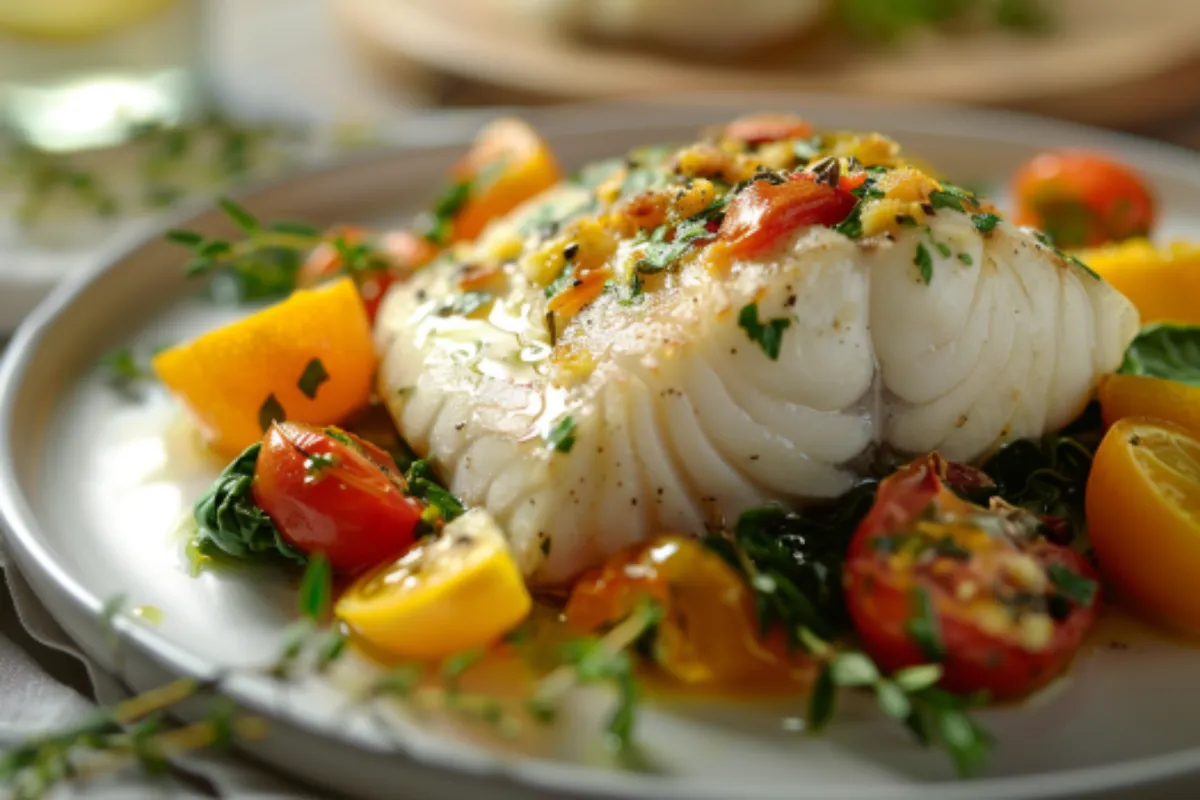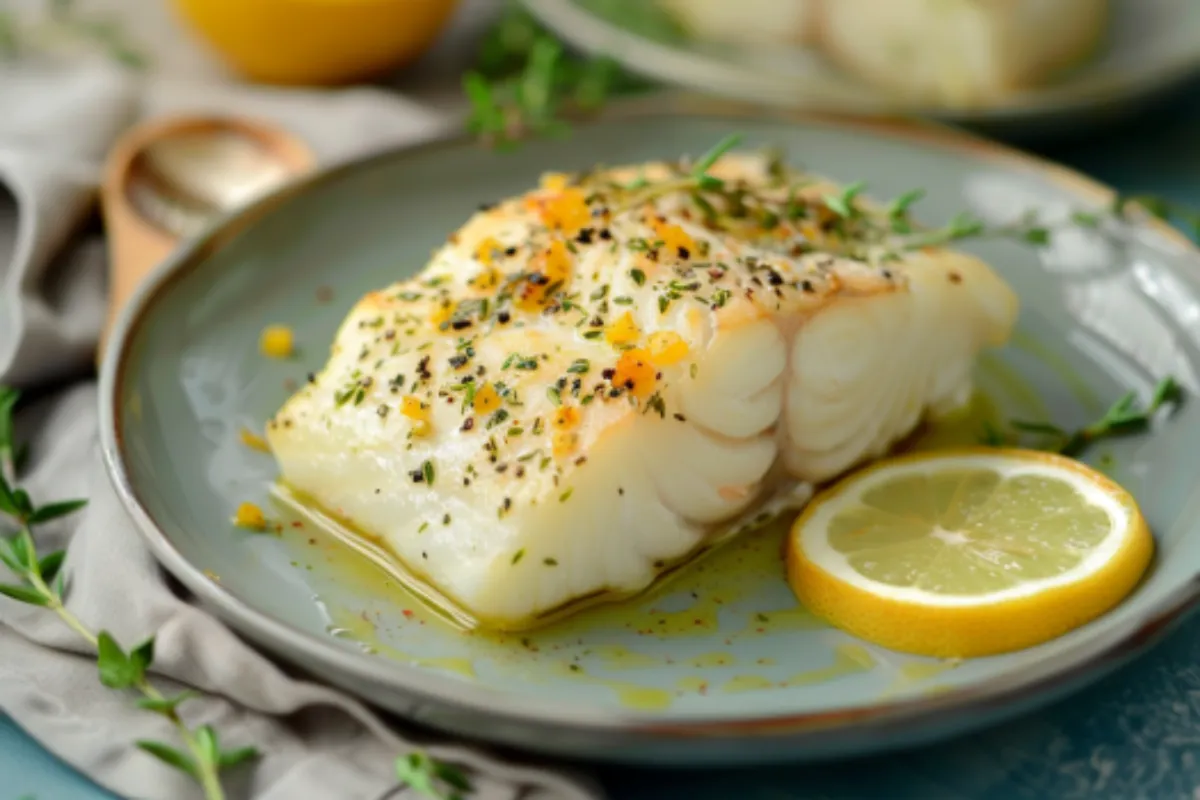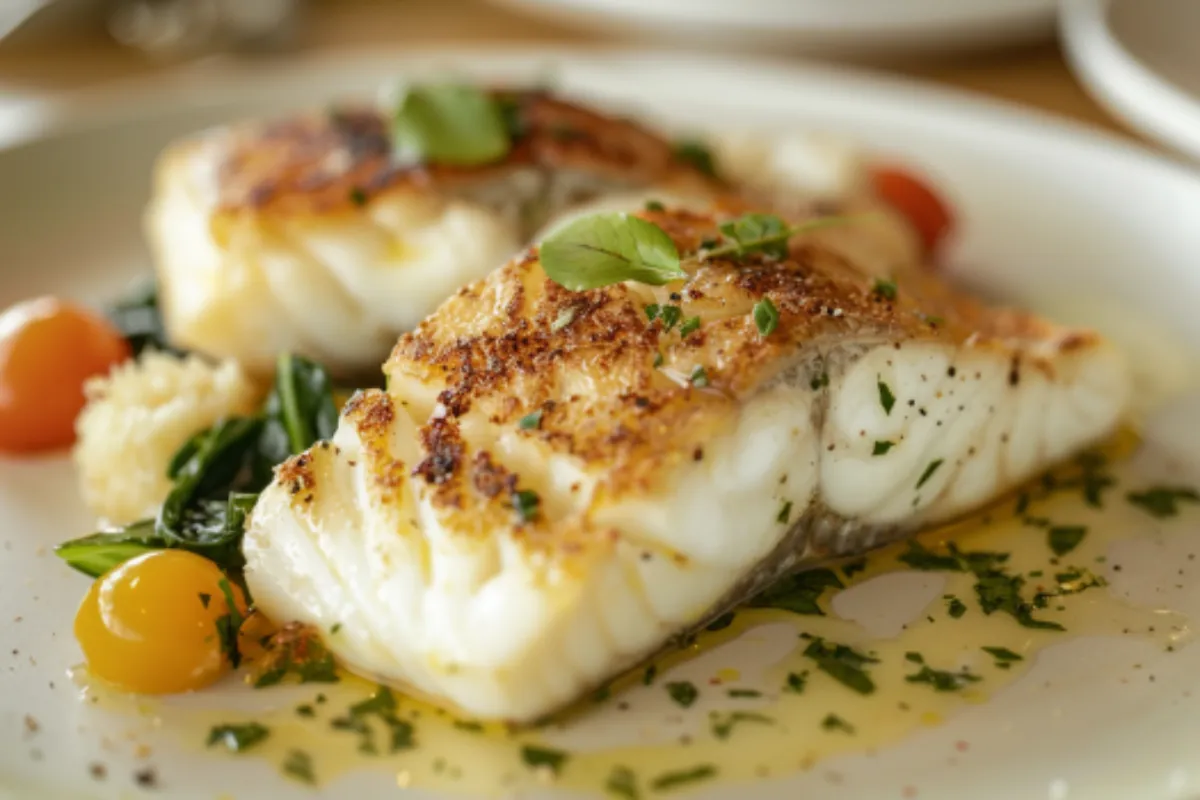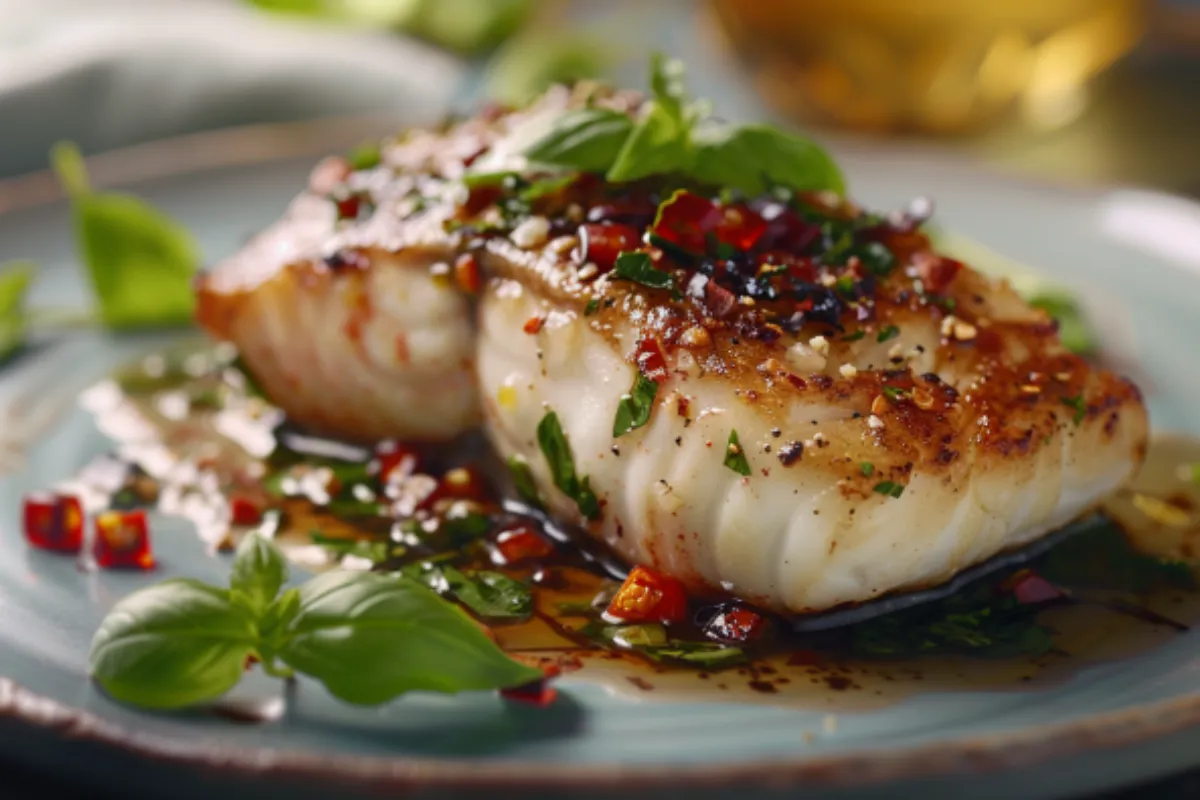Cooking halibut properly can transform this lean, mild-flavored fish into a flavorful and satisfying dish. However, due to its low-fat content, halibut is often prone to drying out during cooking, resulting in an unpleasant texture that is far from ideal. The key to mastering halibut is knowing how to cook halibut without drying it out while enhancing its natural flavors. In this article, we will delve into various cooking methods, tips, and techniques that ensure your halibut remains moist, tender, and delicious. Whether you’re baking, grilling, pan-searing, or poaching, the steps and advice provided here will help you avoid the pitfalls of overcooking and ensure a perfect result every time.
Why Does Halibut Dry Out and How to Cook Halibut Without Drying It Out?
Halibut is a firm white fish that has very little natural fat compared to other types of seafood, such as salmon. This lack of fat, while great for those looking for a lean protein option, means that halibut dries out quickly if overcooked. Understanding how to cook halibut without drying it out is essential for achieving the best results. The most common reasons for dry halibut include:
- Cooking at too high a temperature.
- Overcooking due to not monitoring the internal temperature. Using a meat thermometer can make all the difference, so be sure to check out this guide on how to use a meat thermometer.
- Using cooking methods that don’t retain moisture.
Halibut tends to cook faster than people realize. Its firm texture, when properly cooked, is flaky and moist. Overcooked halibut, on the other hand, becomes tough and chewy. The challenge is to balance heat and timing to achieve a tender, perfectly cooked dish.
Selecting the Best Halibut for Cooking Without Drying It Out

Choosing the right piece of halibut is the first step toward avoiding dryness. Understanding how to cook halibut without drying it out begins with selecting a quality fillet. When shopping for halibut, keep the following tips in mind:
- Fresh vs. Frozen: Fresh halibut is preferable, but high-quality frozen halibut can also work well. If using frozen halibut, be sure to thaw it completely in the refrigerator before cooking to ensure even cooking.
- Wild vs. Farmed: Wild halibut generally has a firmer texture and more pronounced flavor. Farmed halibut tends to be more tender but can be slightly mushy if not cooked properly.
- Fillet vs. Steak: Halibut is often available in two cuts: fillets and steaks. Fillets are thinner and cook faster, while steaks are thicker and require more time. Both cuts can be cooked to perfection with the right techniques, but be mindful of cooking times and thickness when choosing a cut.
Preparing Halibut to Avoid Drying It Out
Before diving into the cooking process, it’s important to properly prepare your halibut. Prepping halibut correctly helps retain its moisture during cooking.
Marinating Halibut
Marinating halibut is an excellent way to add moisture and flavor. A simple marinade using ingredients like olive oil, lemon juice, and herbs will help tenderize the fish and keep it moist. Understanding how to cook halibut without drying it out can be greatly enhanced by using marinades. Some ideas for marinades include:
- Citrus Marinade: A combination of lemon or lime juice, olive oil, garlic, and herbs. The acidity from the citrus helps break down proteins, making the fish more tender.
- Herb Marinade: Olive oil, garlic, thyme, parsley, and rosemary. This adds fresh flavors without overpowering the fish.
- Asian-Inspired Marinade: Soy sauce, sesame oil, ginger, garlic, and a touch of honey. This adds a savory-sweet note to the halibut.
When marinating halibut, avoid marinating it for more than 30 minutes to an hour, as over-marination can lead to mushy fish. Be sure to pat the fish dry before cooking to ensure a good sear if you plan to pan-sear or grill it.
Seasoning Halibut
While halibut has a mild flavor that pairs well with a variety of seasonings, understanding how to cook halibut without drying it out is key to preserving its delicate taste. Keeping it simple allows the natural flavor of the fish to shine. Here are a few seasoning combinations to try:
- Salt, pepper, and olive oil (classic and simple).
- Lemon zest, garlic, and thyme.
- Paprika, cayenne pepper, and a squeeze of lime for a smoky, spicy flavor.
Avoid using too many overpowering ingredients that might mask the delicate flavor of halibut.
Cooking Methods for Moist Halibut

The method you choose to cook halibut is crucial in ensuring it remains moist. Here, we explore the best cooking techniques that prevent dryness and deliver a flavorful dish every time.
Baking Halibut Without Drying It Out
Baking halibut is a fantastic way to cook it evenly while learning how to cook halibut without drying it out, especially when you use lower temperatures and keep an eye on the cooking time. Here’s how to bake halibut successfully:
- Preheat the oven to 400°F (204°C).
- Line a baking dish or tray with parchment paper or foil for easier cleanup.
- Place the halibut fillets in the dish and drizzle with olive oil or melted butter.
- Season the fish with salt, pepper, and herbs or spices of your choice.
- For added moisture, cover the dish with aluminum foil to trap steam and prevent the halibut from drying out.
Tip: Baking halibut with a thin layer of liquid in the dish (such as broth, wine, or a citrus juice mixture) helps add flavor and keep the fish moist.
Bake the halibut for approximately 12-15 minutes, depending on the thickness of the fish. For best results, use a meat thermometer to check the internal temperature. Halibut is done when it reaches 130°F (54°C). Once the fish reaches this temperature, remove it from the oven to prevent overcooking.
For more inspiration, check out the Ultimate Guide to Halibut Recipes for baking ideas and techniques.
Grilling Halibut: How to Cook Halibut Without Drying It Out
Grilling halibut can add a delightful smoky flavor, but the high heat of the grill can dry it out if you’re not careful. Follow these grilling halibut tips for great results:
- Preheat the grill to medium-high heat and lightly oil the grates to prevent sticking.
- Brush both sides of the halibut with olive oil, which helps to lock in moisture.
- Grill halibut steaks for 4-5 minutes per side. Fillets may take slightly less time, so check for doneness often.
- Flip the halibut carefully to avoid breaking the delicate flesh.
To infuse more moisture, consider marinating the fish before grilling or serving it with a simple lemon-butter sauce once it comes off the grill.
Tip: Use a fish grilling basket to make flipping the halibut easier and to prevent the fish from sticking to the grill grates.
Marinating before grilling adds flavor and moisture. You can also baste the fish with melted butter or olive oil while grilling to prevent it from drying out.
Check out this Rotisserie Chicken Recipes guide, which includes helpful tips on basting and grilling techniques that are applicable to halibut.
Pan-Searing Halibut to Keep It Moist and Tender
Pan-searing halibut is a great way to achieve a golden, crispy exterior while keeping the inside moist and flaky. This method is quick and effective for cooking halibut fillets or steaks.
To pan-sear halibut:
- Heat 1-2 tablespoons of oil (olive oil or a neutral oil) in a skillet over medium-high heat.
- Season the halibut with salt, pepper, and any desired herbs or spices.
- Sear the halibut on one side for 4-5 minutes until golden brown, then flip and cook for another 2-3 minutes on the other side.
The key to keeping pan-seared halibut moist is not overcooking it. Like other methods, it’s crucial to monitor the internal temperature. Remove the halibut from the skillet when it reaches 130°F (54°C) and let it rest for a few minutes before serving.
For flavor inspiration, you might enjoy seasoning your halibut similarly to this Pepper Steak Recipe, with bold spices and a savory finish.
Poaching Halibut for Moist and Tender Results
Poaching is a gentle cooking method that ensures the fish stays tender and moist. When poaching halibut, it is submerged in a flavorful liquid and cooked at a low temperature.
Here’s how to poach halibut:
- In a large pan, bring a poaching liquid to a simmer. This can be water, fish stock, white wine, or a mixture of liquid with aromatics such as lemon slices, garlic, and herbs.
- Submerge the halibut fillet or steak in the liquid, making sure it is fully covered.
- Simmer for 10-12 minutes or until the fish reaches an internal temperature of 130°F (54°C).
The poaching liquid not only keeps the fish moist but also imparts subtle flavors. This method is ideal for serving halibut with light sauces, like a dill or lemon butter sauce.
Common Mistakes to Avoid When Cooking Halibut

Halibut can be tricky to cook, especially for those who are new to working with fish. Avoid these common mistakes to ensure your halibut turns out moist and flavorful:
Overcooking
The number one mistake when cooking halibut is overcooking it. Because halibut is a lean fish, it cooks quickly, and overcooking will dry it out. Always monitor the internal temperature and remove the fish from heat as soon as it reaches 130°F (54°C). Halibut continues to cook slightly even after it’s removed from the heat, so taking it off the heat at the right moment is crucial.
Cooking at Too High a Temperature
High heat may cause halibut to cook too quickly on the outside while remaining undercooked in the center. For most methods, medium heat or a moderate temperature is best for cooking halibut evenly. Slow, steady cooking results in a moist and tender fillet.
Not Using a Meat Thermometer
Since halibut can go from perfectly cooked to dry in a matter of minutes, a meat thermometer is a critical tool. This ensures you hit the right internal temperature every time.
Skipping Rest Time
Letting halibut rest for a few minutes after cooking allows the juices to redistribute throughout the fillet. This step is essential for locking in moisture and ensuring every bite is tender.
Creative Ways to Serve Halibut
Once you’ve mastered cooking halibut without drying it out, it’s time to get creative with how you serve it. Here are a few ideas to elevate your halibut dish:
Serving with a Flavorful Sauce
Sauces can add richness and moisture to your halibut. Here are a few ideas:
- Lemon-Butter Sauce: A classic that pairs beautifully with halibut. Melt butter with lemon juice, garlic, and a splash of white wine for a simple yet flavorful sauce.
- Herb-Cream Sauce: A light cream sauce with fresh herbs like dill, parsley, and chives adds freshness and richness to the dish.
- Cilantro-Lime Sauce: For a zesty, bright twist, blend fresh cilantro with lime juice, olive oil, and garlic.
Adding Toppings and Garnishes
Enhance your halibut dish with these simple yet impactful garnishes:
- Toasted Almonds or Pine Nuts: These add a delightful crunch and nutty flavor.
- Fresh Herbs: A sprinkle of parsley, dill, or basil adds a fresh touch.
- Citrus Slices: Serve halibut with a wedge of lemon or orange for an added pop of brightness.
Serving with Side Dishes
Halibut is a versatile fish that pairs well with a variety of sides. Consider these options:
- Roasted Vegetables: Broccoli, asparagus, or Brussels sprouts roasted with olive oil and garlic complement the lightness of the fish.
- Rice or Quinoa: A simple side of rice or quinoa serves as a neutral base for the flavors of the halibut and sauces.
- Potatoes: Whether mashed, roasted, or boiled, potatoes are a classic pairing with halibut.
If you want more pairing inspiration, take a look at this guide on What Goes Well with Halibut, which offers plenty of ideas for side dishes and sauces.
Frequently Asked Questions About How to cook halibut without drying it out
1. What is the best cooking method to keep halibut moist?
The best methods to keep halibut moist are baking, poaching, or pan-searing at moderate temperatures. These methods allow you to control the cooking time and retain moisture.
2. What temperature should halibut be cooked to?
Halibut should be cooked to an internal temperature of 130°F (54°C) for optimal moisture and tenderness. Using a meat thermometer helps ensure it doesn’t overcook.
3. How do I prevent halibut from sticking to the grill?
To prevent halibut from sticking, preheat the grill to medium-high heat and oil the grates. Additionally, brush the fish with olive oil before placing it on the grill.
4. Can I marinate halibut, and for how long?
Yes, marinating halibut is a great way to add moisture and flavor. Marinate for 30 minutes to 1 hour, but avoid over-marinating to prevent the fish from becoming too soft.
5. Should I remove the skin before cooking halibut?
The skin can be left on during cooking to help retain moisture and prevent the fish from falling apart. However, it is typically removed before serving, as it can be tough.
Conclusion: About How to cook halibut without drying it out
Cooking halibut without drying it out may seem challenging, but with the right techniques and attention to detail, it can easily become a flavorful, tender dish that impresses every time. Understanding how to cook halibut without drying it out is essential. By carefully selecting the right cut, preparing it with the right marinades and seasonings, and choosing gentle cooking methods like baking, grilling, pan-searing, or poaching, you can ensure that your halibut retains its moisture and flavor.
The most important factor is to monitor the internal temperature and avoid overcooking. Resting the fish after cooking allows the juices to redistribute, ensuring every bite is moist. With the tips outlined in this article, you’ll have everything you need to cook halibut perfectly, regardless of the cooking method you choose.
With these insights, you can confidently prepare halibut that’s not only delicious but also perfectly moist. Happy cooking!

